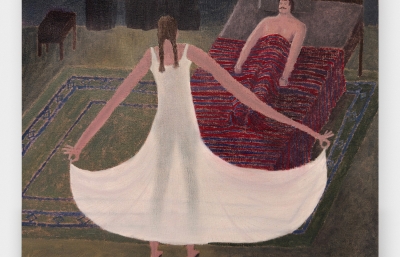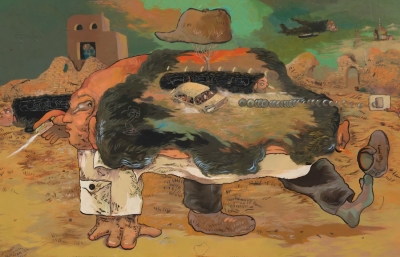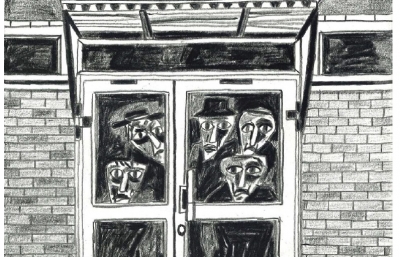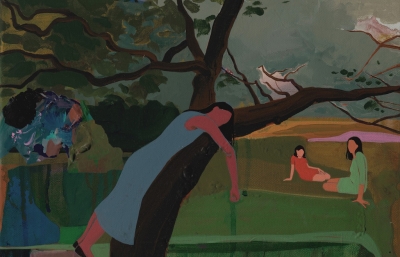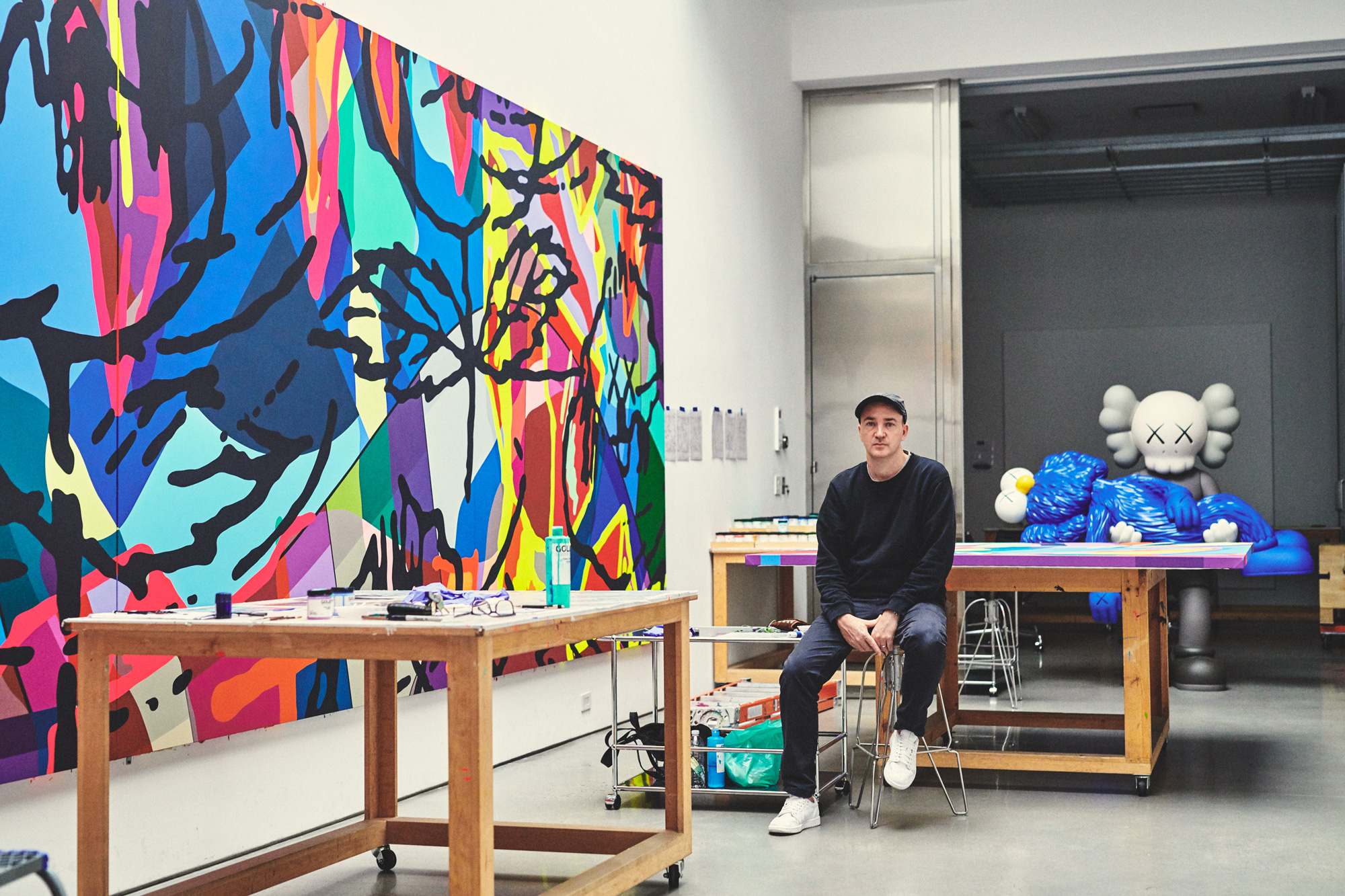
KAWS
Art Louder Than Words
Interview by Evan Pricco // Portrait by Bryan Derballa
It’s hard not to notice the astronomical change in the art landscape over the past 25 years. The notoriety and fame that a generation of artists have achieved while still active in both the fine art and pop culture realms seems unprecedented. Sit back and wonder why, and the conclusion may be that social media, celebrity interest, and their integration of art, music, and product have changed the game. Thinking of the most famous artists in the world, Haring, Warhol, and Basquiat, for example, I see a blueprint for what was to come in the 1990s and twenty-first century. But there hasn’t been an artist over the last 25 years who exists in his own stratosphere, his own singular universe, quite like the artist we know as simply, KAWS.
From toys to graffiti, fine art to fashion, art collecting and public art that bridges American pop culture to an international audience, KAWS has defined an era where the artist can be whatever he or she wants to be without compromise. And, in many ways, KAWS has achieved success as an artist without being shackled to a particular thing, a genre, if you will. He really is known as just KAWS, and by and large, he is quite content.
I sat down with KAWS over the course of two meetings, one in Tokyo in the spring on the eve of a solo show at Perrotin, and later in the fall at his Brooklyn studio while he prepared works for an upcoming solo show at Skarstedt Gallery in NYC. The latter would be the first solo show in his hometown in over five years, a detail not lost on the artist. We discussed his relationship with Japan, graffiti, art school and his ability to avoid being pigeonholed in particular urban and street genres. He was forthcoming and honest as we navigated through the last 30 years of his life.
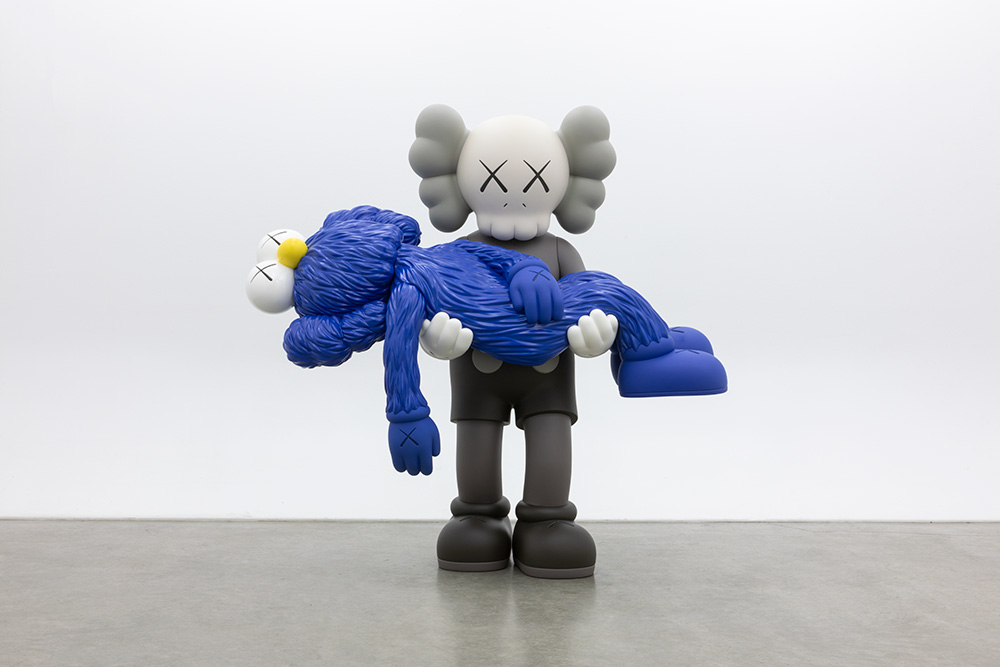
Evan Pricco: I noticed your comment on Instagram, something about you not having been to Japan in a while. That just didn't seem right. I associate Japan with your early success.
KAWS: Yeah, it doesn't seem right. I used to come, like, every two months, when I had my Original Fake brand. After having my first kid… you want to travel less when kids are brought into the mix.
Take me back to this far away land that was before social media, before everything was so connected, like when you were first coming to Japan and the energy of the culture that was happening at that time. People talk about it as a mystical time, but it wasn’t that long ago! What made it so distinct?
Nostalgia. I think there's a lot of integrity in Japan. There were a lot of guys who were pushing things in a way that really nowhere in the world was pushing, as far as, say, street wear. There wasn't much of a gallery scene when I first came in the ’90s. I was baffled. I grew up around New York, and you just assume the whole world has galleries and has a scene of some sort. You might not be privy to it, but it exists. In Tokyo, there were a couple of galleries, but it wasn't as jumping as I thought it would be. Streetwear, on the other hand, was very active. I was fortunate that, through STASH and FUTURA in New York, I got to meet these guys at Mad Hectic, which inevitably led to me meeting Nigo from BAPE, and all these great people. If you're going to land, landing within that world is pretty good. I think it was a good, curious time. They were curious about New York, we were curious about Japan, and just naive creativity happened.
And today, culture is just a bit more self-conscious.
It's super self-conscious. And with social media, there's nothing intimate about anything. You can't do a T-shirt for a little local market. It just doesn't exist. It'll get bastardized, bought, resold. But, at the time, I think everybody was just happy to be making what they were making, excited about making good fucking stuff: clothing, toys, design, packaging. The packaging was amazing! Just a focus. It just seemed like I was lucky that I came into all of this at that particular moment.

What things got you into wanting to do art?
Lack of any inspiration anywhere else. honestly. I didn't know any working artists growing up. I didn't think of art as a profession. I just thought of it as a way to get by at school and a way to get around social situations. At a certain point, until late in high school, not that I realized that you can make a living in art, I just realized I'm not going to make a living any other way. So, little by little, you just check the boxes off; "Not going to be this, not going to be that." In fifth grade, a teacher did tell my mother, "He could pursue art?" My grades were so horrible that I think my teacher wanted to comfort my mom in some capacity.
And then graffiti was great because it helped me learn about kids all over the world, that there really was this community unlike any that exists, even now, in contemporary art. It's a different thing and people outside it don't understand.
Graffiti has that weird, almost Grateful Dead community quality where it's like passed around. Before the internet, it was passed around in this really organic, insider way. It really was a community that did so well at communicating with each other.
Exactly. But it was just like within a certain group, and outside the circle, no one had a clue and could care less, obviously. I mean, you talk about some of the graffiti stuff and it just seems totally ridiculous to a regular adult. So, I felt fortunate to have that, and to have that coupled with my interest in design and art.
The thing, too, if you didn't grow up in New York, it would have been harder at that time.
Absolutely. I think it all has to do with who is around you, what you grow up seeing, what you grow up not liking, and figuring out how to surround yourself with stuff you do like. Access would have probably been a lot harder had I not been a few blocks to the train that led to Manhattan.

What you're saying, too, is there's this thing where you didn't know any professional artists growing up, which is not to say any of us did. But, at that time, there were graffiti artists who came out of the 1980s with shows; perhaps it was a little rough when it got to the 1990s. But then a whole new crop of artists came into the 1990s better equipped, maybe?
In the ’90s, I was painting with Zephyr, and I knew these graff guys who had great moments in the ’80s with galleries. It happened and then stopped. Then the next wave came, and someone like Barry McGee was just fucking trailblazing. When he came to NYC and did the show at the Drawing Center in 1996, what he was doing was the first sort of tangible thing that somebody from this graffiti world could crossover with. But it was not like the ’80s, this was very specific. Barry sort of discarded a lot of what came before in the gallery world. He had a completely unique point of view and aesthetic. He reinvented it, and did it in a way where you just thought, "Whoa. There's actually space for new conversations to enter." And Street Market, with Barry, Todd James and Steve Powers… it was an interesting time.
So, for you, just out of school at SVA, where was your mindset? What were you doing outside of your graffiti?
I was hopefully going to get a job in the creative field. That's how I worked in animation. I never really cared about animation, it was just a check and I could paint all day. And I loved SVA. Good teachers, loved it. I never had any experience like that prior, you know, through high school. There was just never any serious consideration about the arts, and then suddenly you have people teaching you bare bones facts about painting. It was just sort of this epiphany like, "I can't believe people do this." So, I went from being a horrible student to just wanting to focus, and work hard. And the day after I graduated, I started working in animation.
You weren’t into that kind of crossover stuff at that point? Like trying to do a graffiti-fine art hybrid?
No, I mean, I did the billboards, but that all just fell within piecing, and I was more into doing, say, walls. In Washington Heights, the Bronx, anywhere. Freight trains and things like that. It wasn't really, "How am I going to parlay this into a career?"
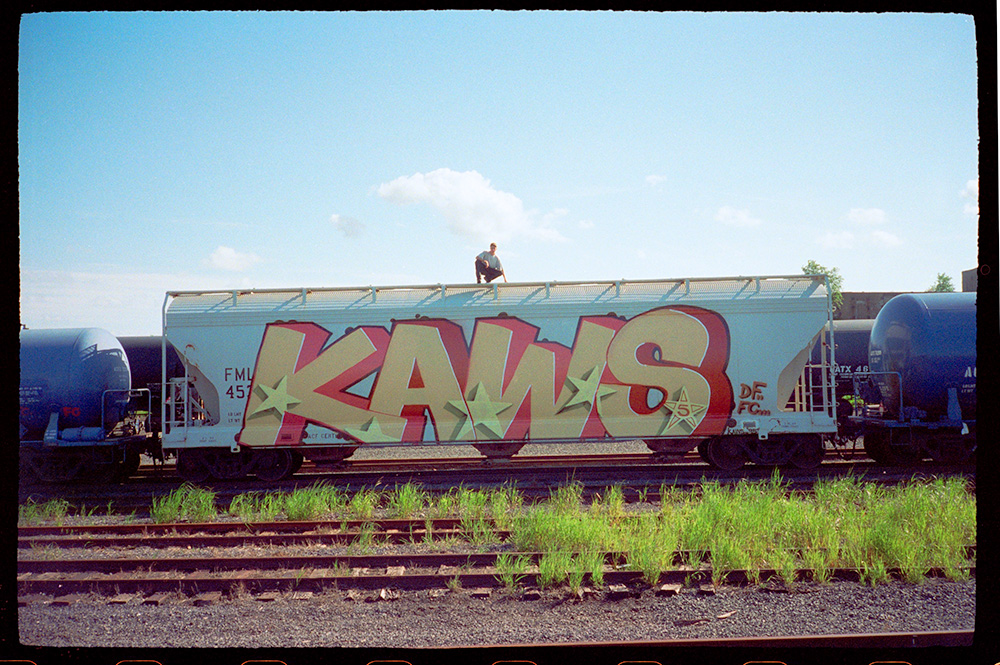
Were there little signs that things you were into outside of graffiti were becoming avenues for a “greater” art career?
I still have those moments. I mean, things happen now, and I'm like, “Wow. Six months ago, I never would have imagined, and suddenly this happened." And after that happens, and you see it, you kind of imagine what else could happen, you know? I think that, in the beginning, Tokyo was really tied to that. You just work your way around ideas and opportunities.
Even at the beginning, you seemed to understand this idea of demand, where you knew about how to make something super limited, but at times, weren’t afraid to really make a product accessible. But you never overdid it, which is interesting.
I don't know. I guess that depends on who you ask. I was more interested about learning and navigating around my interests and figuring out how to create a long-lasting trajectory. There were definitely moments in the early 2000s, where there was an abundance of money floating around and an opportunity to license and do stupid stuff, and I always kind of cringed at a lot of that. If I couldn't stand next to it, I wouldn't do it. That said, I might have done a couple of dumb projects along the way, but not enough to overshadow the good stuff.
Do you always make sure to produce a couple of things a year that the average kid can afford?
Uniqlo was one of my favorite projects. I want to keep doing that just because, for so long, things I did were sort of limited and there was more to do with our budget and what we could handle with distribution. There was a moment in the early 2000s where doing the super-limited thing just felt right, and now I'm just in a different mood and I feel like with Uniqlo and social media, you suddenly have all of these younger kids looking at your stuff. I like doing a project where you see kids snag a shirt that's $14. And then, out in the world, you'll see it mixed with super high-end stuff. That is a nice part of culture, this balance now. I was in Melbourne recently, and I saw so many people wearing the shirts on the street that it made me think, in a good way, "This is so weird."
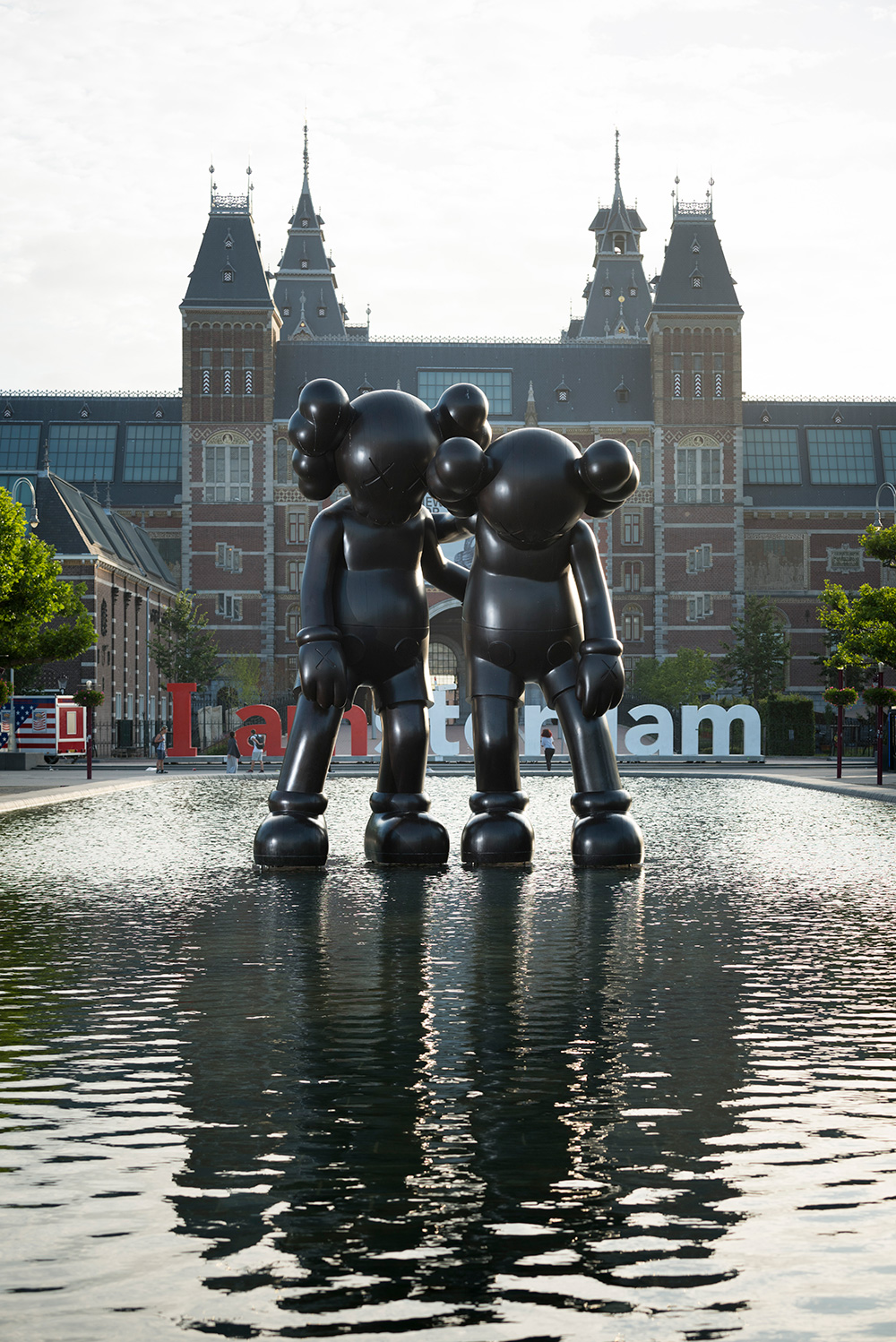
Over the summer, between our two meetings, KAWS was busy with a myriad of projects that seems to define his workflow at this moment in his career. Public sculptures emerged in Qatar, China, Los Angeles and South Korea, as well as another solo show in Hong Kong with Perrotin. Plus, his studio released new signature vinyl toys with his longtime collaborators, Medicom, as well as a collection of Sesame Street collaborations through Uniqlo. After the international jetsetting, we reconvened at his Brooklyn studio.

Evan Pricco: It’s amazing to me that you have been able to stay out of being “grouped” with other artists. Like you aren’t attached to a scene, per se. That is hard to do.
KAWS: I just don't accept those things. I feel like people who want to clump me into a category are not really looking at what I do. They're just looking at having a group. Like, "Oh, let's have a street art show." It doesn't matter who they invite, it's just a street art show. I try not to generalize when I look at artists.
When you started getting into graffiti, did you feel like, "OK, I've found a like-minded group of people," or was it always something you were doing on your own?
I had multiple groups of people. I mean, that's what I liked about the craft. I didn’t grow up involved in any sports, I never had any sort of team camaraderie. Suddenly, there’s a realization, "Oh, these guys like to break into spaces and paint, too. That's great." You know, there's actually, like, real consequences and you rely on people. In general, I've bounced around solo to different groups, whether it's doing freight trains or billboards, and I always do that with one person or something. The phone booths were really kind of the solo. When I moved to Manhattan in ’96, I was just focused.
How long did it take, let’s say, with the phone booths, for people to really start noticing what you were doing on the street? If you did this today, it would take 10 minutes for the world to know you were doing phone booths, but at the time, it could take months for a story to emerge. You would need a magazine months down the line to help tell the story.
You had to have at least a year or two to just be doing something until finally all your friends knew what you were doing!
You can make mistakes or experiment without the world watching.
Exactly. When I started doing the ads, it was great because I felt like I was just putting them out, but I was getting nothing back. Sure, I was getting photos and stuff, but as far as who knew I was doing them, it was a small group. It was just what I wanted. Put it out, not hear back, think about it, put it out…

Do you remember why you started doing that? Why the ads? Was there something that you were thinking, "Oh, this is more at street level, this is interesting.”
In Jersey City, with the billboards, you can get to them. They're great spots. The companies had done all the research. These locations reach a lot people. Then, just seeing the artwork over an advertisement, I just liked that mixture. Moving to Manhattan in '96, I really shifted over to focusing on phone booth ads just because, I don't know, it was more tangible.
So you just graduated from SVA, had a job in animation, were doing the street works… was there a need to get into the gallery world at this point?
I was an Illustration major. I thought I'd have to get a job to subsidize the stuff I did in the street. It was just never really an option. And to be honest, NYC wasn’t really showing the stuff I was doing.
That’s why Japan was so important to you.
I made the first toy in 1999. I had been going to Japan and finding opportunities there, random opportunities that kept popping up, just not so much from the U.S. It wasn't like the galleries were looking at that world in any way at all. I like making products and stuff. In the U.S, it just felt as if, “Oh, you could be a fine artist or you could be a commercial artist.” There was a split division: if you do this, you can't do that, like one thing knocks out the other. There is definitely truth in that, and still, even today you get that. You have people who are a little bit scared of commercial projects or still pretend that there is this church.
There is less of a church now, which is nice.
There is for some people, but for me, I enjoy just having work disseminate in different countries at the same time. That can never happen in a gallery space.

It seems to me this all ties into what we said earlier, that you have been independent of scenes, like taking control of your name without giving it away at a pretty early age, and that’s an important note for any younger artist.
If I ever do a project, that's me wanting to do that project, me having a reason in my head why I feel that's a good project. I've managed, luckily, knock on wood, to do things within my terms. Not everything. You get burned. You realize you can get into something, and it's not what you would imagine. I always knew, at the end of the day, it's going to be me sitting here with my work and myself. No matter what you make, you're not going to have it for long, I don't think. I don't anyway.
Do you think that's the graffiti background talking?
It could be. It’s definitely a great training ground. I mean, that's everything. Basically, speaking for myself, you build an image and a presence.
And a name, like a brand name, in a sense.
Just by the way you project yourself. It's not very different.
Another thing you have been synonymous with in recent years is your art collection. Not only do you share your collection on Instagram, but you also show a lot of art you like, or that influences you, and that may come as a surprise to followers who only know you through toys, or only through fashion. It's a good practice for everybody who's a fan of yours or a follower, to see things that you also like. It breaks the idea of boundaries of what you are allowed to like.
I see stuff that I feel should be seen. You know what I mean? That's really why I post stuff. I just like looking at some particular art and I'll post it. It's not really that methodical, it's more about, “This is stuff I like.”
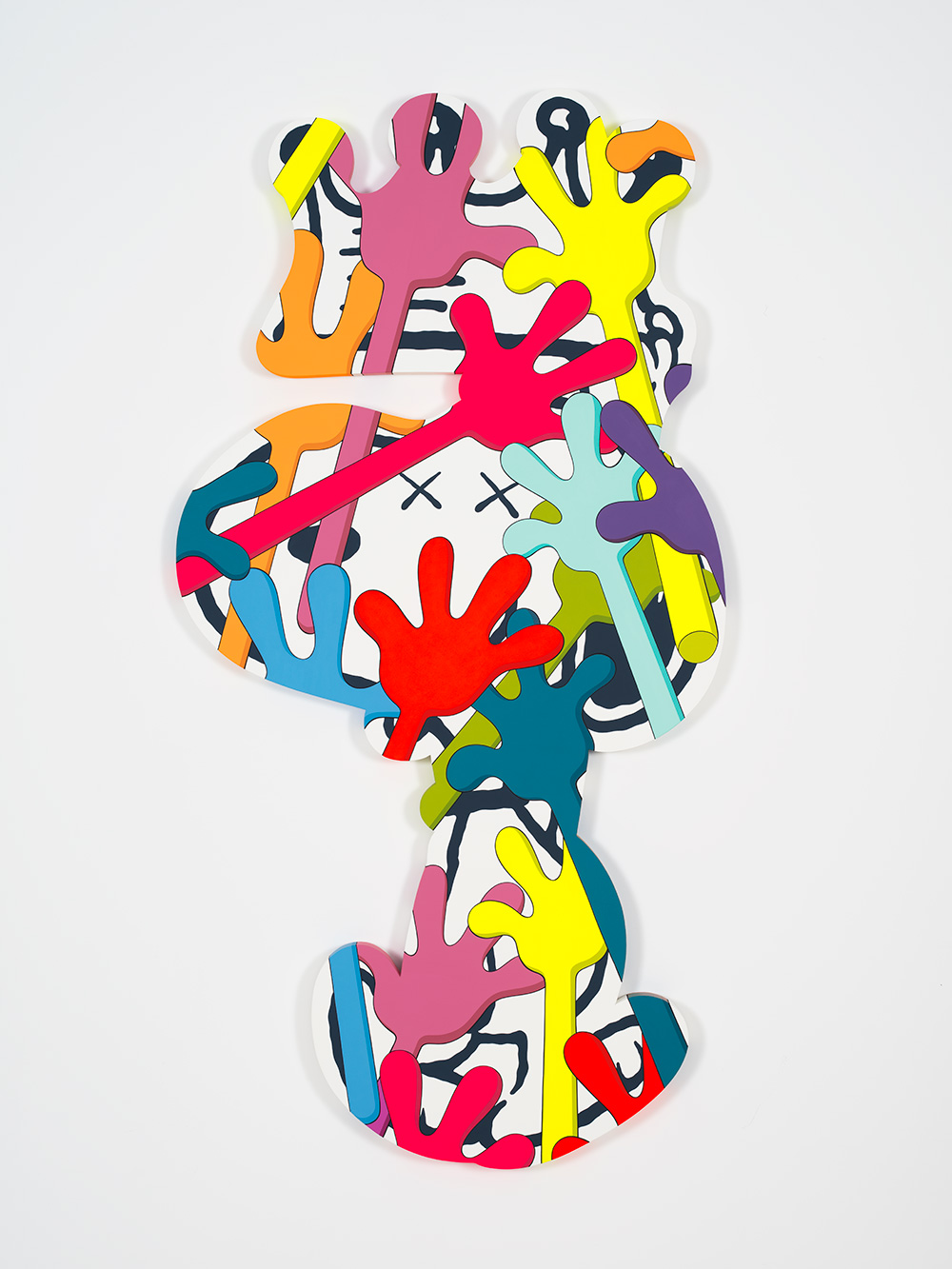
It shows a bit of personality, too.
It's a little hard to extract that personality out of me. I've always hated the smoke and mirrors from artists ahead of me, where you get to see this staged photo and that's what they stick to. I think, especially for kids following me, I try and make the point that you literally can do this. You can get into art. I mean, it's a fucking nightmare to navigate, but the playing ground, there are access points. There is nothing keeping you from learning. There is nothing keeping you from picking up books and going to museums, and what you do with that information is your choice.
That’s the exact message that artists like yourself should champion to people. Just because prior history has created a complex lexicon of “art knowledge,” you can still participate in art just by liking it.
Exactly. You can still know it. You can still understand and appreciate art.
Is that why you try to do both the high end and pop-culture releases, often around the same time? To keep an active and engaged audience feeling appreciated?
I do consciously think about how things disseminate. If I do something like Dior, I also want to do something like Uniqlo. I don't feel like it's my job to be the affordable artist. I want to make good stuff, and if I can find a place and make good stuff that can be all over, then great.
Another function of working with the likes of Dior, or then Snoopy and Sesame Street, goes back to that role you play in the art world and with your social media. It reminds people that from Dior to Sesame Street, these brands were created by artists. There is craft behind all these high-end and pop worlds.
Yeah, it’s coming from real people. I always think about how things are made. I don’t want to just exist and not know about my surroundings. That’s in art, fashion, architecture, movies… anything.
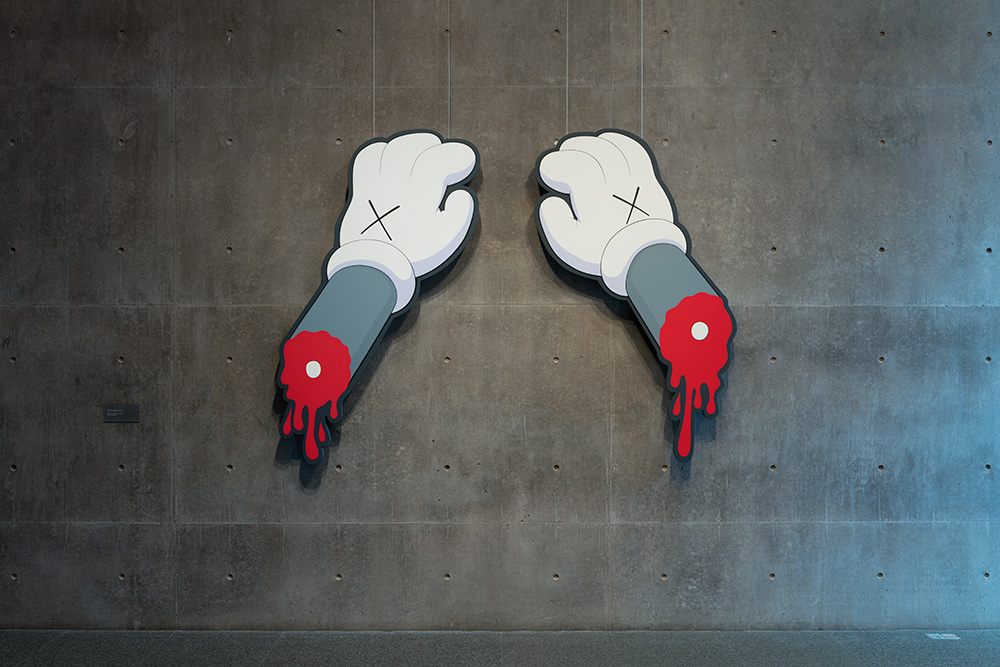
You had a really busy summer. After Tokyo and Hong Kong, there was the Dior project, public sculpture works in China, Korea, Los Angeles, Uniqlo releases, new toys, and I’m probably missing something. Now it's about focusing on your gallery show at Skarstedt Gallery in NYC opening by the time this issue comes out. Is that technically slowing down for you?
It is slowing me down a little bit. I mean, I have been focused on the show in November, just because it's New York. I haven't shown in New York in five years.
Because it's New York. Because it's where you're from, is there any added, I hate to say, pressure?
There is no way to add more. I pretty much try to do the best stuff I can do every time I can do something. I'm happy that my friends from around here can see the work, instead of just seeing stuff from social media.
For the sake of nostalgia, if I was talking to 1994 you, Brian Donnelly, would you be surprised by the summer of international projects, as well as a major solo show in NYC?
I never imagined being able to not have a job. I always thought it'd be great to have a good job, that I can afford an apartment and really just do what I want to do personally and get work made. To be able to just work for myself and make the paintings I make and reach an audience like that was just not really in my mind.
You don't consider this a job?
Definitely not. No. I mean, I may work harder than most people that show up at work, but it's not actually work, though. Not when it's fun and you're excited about it. You can do it endlessly. Sixteen hours would fly by and you could just be like, “huh.”
And this career that spawned from graffiti has now grown to such a massive international audience.
it's just always been about communication, and I've found other means. Now I get to have that dialogue with the world.
KAWS' New solo show on view at Skarstedt Gallery in NYC through December 19, 2018.

